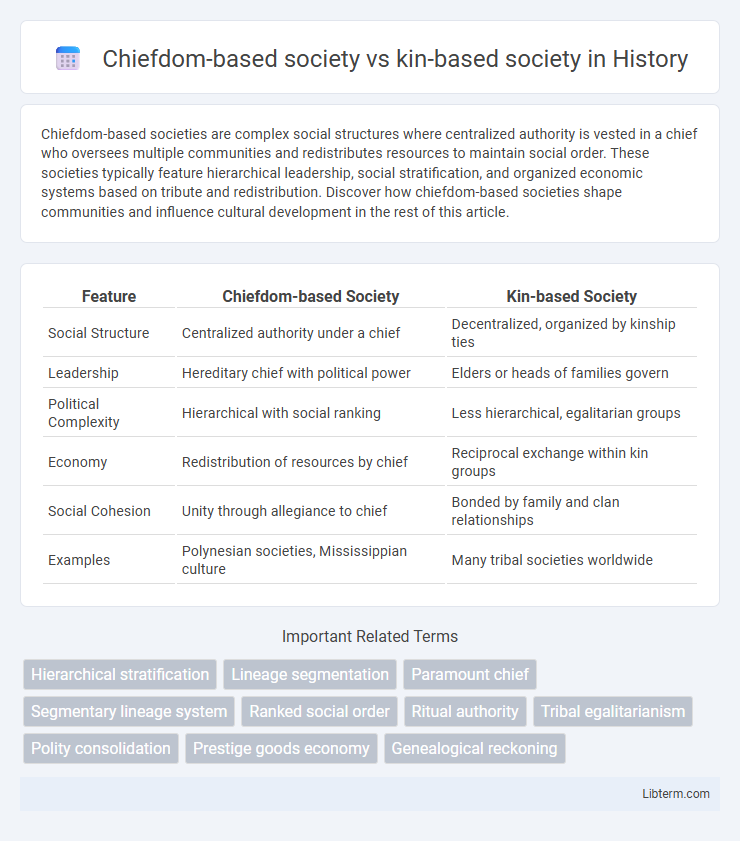Chiefdom-based societies are complex social structures where centralized authority is vested in a chief who oversees multiple communities and redistributes resources to maintain social order. These societies typically feature hierarchical leadership, social stratification, and organized economic systems based on tribute and redistribution. Discover how chiefdom-based societies shape communities and influence cultural development in the rest of this article.
Table of Comparison
| Feature | Chiefdom-based Society | Kin-based Society |
|---|---|---|
| Social Structure | Centralized authority under a chief | Decentralized, organized by kinship ties |
| Leadership | Hereditary chief with political power | Elders or heads of families govern |
| Political Complexity | Hierarchical with social ranking | Less hierarchical, egalitarian groups |
| Economy | Redistribution of resources by chief | Reciprocal exchange within kin groups |
| Social Cohesion | Unity through allegiance to chief | Bonded by family and clan relationships |
| Examples | Polynesian societies, Mississippian culture | Many tribal societies worldwide |
Defining Chiefdom-Based Societies
Chiefdom-based societies are characterized by a centralized authority led by a chief who holds political, economic, and religious power, typically overseeing multiple communities or settlements. These societies exhibit hierarchical social structures with ranked classes and institutionalized leadership, often supported by redistribution of surplus resources managed by the chiefdom. Chiefdoms differ from kin-based societies by formalizing leadership roles beyond family ties, creating more complex governance systems and organized social stratification.
Understanding Kin-Based Societies
Kin-based societies organize social structure primarily through family lineage and extended kinship ties, emphasizing reciprocal obligations and communal support within clans or tribes. Leadership roles in kin-based societies are often informal and arise from seniority or personal influence rather than centralized authority typical of chiefdoms. These societies rely on strong kin networks to maintain social order, distribute resources, and resolve conflicts through consensus and customary laws.
Hierarchy and Leadership Structures
Chiefdom-based societies feature a formalized hierarchy with a centralized leadership, where a chief holds authority over multiple communities and enforces social order through status and hereditary power. Kin-based societies rely on familial ties to organize social structure, with leadership often shared or rotated among elders or heads of kin groups without a centralized authority figure. Power in kin-based systems is more egalitarian and consensus-driven, while chiefdoms exhibit ranked social strata and institutionalized leadership roles.
Social Organization and Roles
Chiefdom-based societies feature hierarchical social structures with centralized authority embodied by a chief who controls resources and enforces laws, often supported by a stratified class system. Kin-based societies rely on extended family networks and clan affiliations to organize social roles and responsibilities, emphasizing cooperation and reciprocity within kin groups. Leadership in kin-based societies is typically decentralized, with roles distributed among elders or influential family members rather than a singular ruling figure.
Economic Systems and Resource Distribution
Chiefdom-based societies feature centralized economic systems where resource distribution is controlled by a hierarchical leadership, often led by a chief who redistributes goods to maintain social order and status. Kin-based societies rely on reciprocal exchange and communal sharing among family and clan members, emphasizing kinship ties rather than centralized authority for managing resources. Economic transactions in chiefdoms often involve tribute and ceremonial redistribution, whereas kin-based groups prioritize direct reciprocity and collective labor contributions.
Conflict Resolution and Law
Chiefdom-based societies rely on centralized authority where leaders mediate conflicts and enforce laws through hierarchical structures, maintaining social order via established customs and formalized sanctions. Kin-based societies resolve disputes through clan elders or family councils, emphasizing consensus and restorative justice rooted in kinship obligations and communal harmony. Legal systems in chiefdoms tend to be codified and enforceable by the chief's decree, whereas kin-based societies depend on oral traditions and relational norms to manage conflicts.
Inheritance Patterns and Succession
Inheritance patterns in chiefdom-based societies often follow a formalized, hierarchical system where leadership and property pass through hereditary lines, typically favoring primogeniture or designated successors within a ruling family. Kin-based societies usually exhibit more fluid inheritance practices, emphasizing clan or lineage ties without rigid, centralized authority, leading to shared or negotiated succession among kin groups. Succession in chiefdoms is marked by established protocols that reinforce social stratification, whereas kin-based societies rely on consensus and customary norms to determine leadership transitions.
Rituals, Beliefs, and Cultural Practices
Chiefdom-based societies feature centralized leadership with rituals reinforcing the chief's authority, often involving elaborate ceremonies and sacred symbols that legitimize power. Kin-based societies emphasize familial ties, where rituals and beliefs focus on ancestor worship, kinship bonds, and communal rites to maintain social cohesion. Cultural practices in chiefdoms include hierarchical status displays through feasts and offerings, while kin-based groups prioritize reciprocal exchanges and collective rituals that strengthen lineage identity.
Strengths and Weaknesses of Each System
Chiefdom-based societies offer centralized leadership that facilitates coordinated resource management and societal organization, strengthening social cohesion and decision-making. However, their hierarchical structure can lead to power imbalances and reduced individual autonomy. Kin-based societies emphasize family ties and egalitarian governance, promoting strong social bonds and mutual support, but may struggle with large-scale coordination and conflict resolution beyond immediate kin groups.
Evolution and Transition between Societal Types
Chiefdom-based societies evolved from kin-based societies through increased social complexity and the emergence of centralized leadership that managed resources and resolved conflicts. The transition involved the development of hierarchical structures where chiefs exercised authority over multiple kin groups, enabling broader social coordination and territorial expansion. This evolution marked a shift from egalitarian kinship ties to stratified power dynamics influencing economic redistribution and political organization.
Chiefdom-based society Infographic

 libterm.com
libterm.com